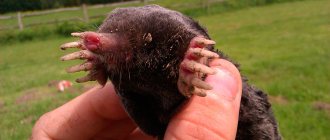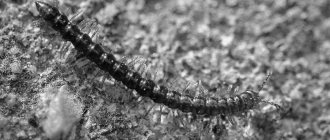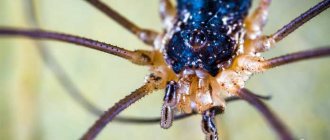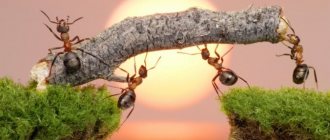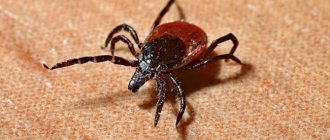Author: Michael Potter Updated: January 31, 2020
The centipede (centipede) is not the most harmful creature that lives near humans, but it is certainly one of the ugliest and most frightening! They are feared for many things: high speed, strange appearance and the possibility of being bitten.
Therefore, the fight against centipedes often turns into real hell for people. We will destroy all myths about them based on strictly scientific and verified data.
First, we will answer the most popular questions about what centipedes look like and where they live. And then we’ll find out if they bite and are poisonous. And also what to do if you are bitten by a centipede. But first, let's take a closer look at these disgusting creatures.
So how many legs does a centipede actually have, is there really 40 or 42? There's an answer!
Different types of centipedes also have different numbers of limbs. On average, they have from 15 to 20 pairs of legs along their body, although there are centipedes with 60 or even 80 legs.
Under the influence of the evolutionary process, the first pair of limbs of the centipede was transformed into special jaws, which are adapted to hold their prey. Almost all centipedes go hunting at night. Having caught the victim, the centipede injects poison into its body and thereby causes terrible and acute pain (just like from a wasp sting). The basis of their diet consists of small insects - slugs, snails, worms and others.
Centipedes belong to a class group called invertebrates. They have an elongated body, which consists of many segments and limbs. Previously, they were considered the closest relatives of insects, uniting them with the last representatives in a group called taxon.
However, over time, the opinions of experts were divided:
- some classify them as representatives of crustaceans;
- others speculate that they are similar to chelicerates;
- Still others believe that millipedes are a paraphyletic group in relation to insects, which means that apart from ancient family ties they have nothing in common.
But still, people continue to worry about the question of how many legs centipedes have, because no one can answer it accurately. Just look at the creatures and understand that they have many limbs.
Depending on the type, their number can range from several tens to several hundred.
There are 12,000 varieties in nature. The number of legs depends on several factors:
- invertebrate species;
- body parameters;
- gender accessories;
- habitats.
In fact, the number of legs of centipedes is not 40, it can be from 10 to 173. The record holder for the number of limbs is the black African nodule - it is endowed with 400 legs. In 2005, scientists identified a representative of the creatures, which for many years was considered an extinct species. They counted 750 legs. The length of the body was 33 cm.
The number of legs depends on the parameters and length of the body. For example, giants, which can have a body length of 35 cm, have over 100 legs. Within one species there are creatures with different body sizes and the number of legs. Females have 2-3 times more of them compared to males. It is worth paying attention to the fact that as insects grow older, the number of legs in insects increases. They can be almost invisible or arachnid-like.
It happens that creatures’ limbs are too long; this is usually observed in representatives that live not only on land, but also in water.
How many legs does the Common Flycatcher have? Watch the entomologist's story on video
What to do if you are bitten by a scolopendra
But if you do get bitten by a scolopendra, be prepared for the following consequences (we’ll warn you right away, not fatal). The bites can be very painful and go away slowly over 1-2 days. The main symptoms that you may experience: at the very moment of the bite there will be a sharp and prolonged pain; the severity of the pain can vary (from slight to “10” on a 10-point pain scale); body temperature may increase; you may feel severe weakness; Most likely, the sensitivity of the skin in the bite area will significantly increase, swelling and redness will appear, and loss of sensitivity and a feeling of numbness may also occur.
Scolopendras are somewhat similar to wasps, which do not leave a sting in the wound and can sting a person several times in a row. Often, at the moment of detection by a person, this creature continues to inflict multiple punctures, introducing even more poison. Centipedes usually bite when a person is resting in bed, but they can also crawl into clothes and bite the moment you start getting dressed.
But there is good news: scolopendra bites are not fatal! For a person to die from its poison, he must be bitten by several thousand individuals at the same time!
Helpful advice: if you are bitten by a scolopendra, find a heating pad at home, fill it with moderately hot water (up to 45 degrees C) and apply it to the bite site - this simple measure should bring relief. Scientists have not yet found an explanation for this phenomenon, but they suspect that this is possible due to the fact that some components of scolopendra venom are unstable to heat. The second remedy is ice and analgesics.
Are centipedes dangerous for your home?
And you don’t have to worry about clothes, paper documents, furniture and other items. A centipede is not a moth or a silverfish. She is not at all interested in your things. Another thing is that some centipedes can spoil the air in the house due to the fact that they secrete a bad-smelling secretion - but even that is unlikely - there must be too many of these arthropods in your house for you to smell it. In addition, since centipedes are plant scavengers, they may become interested in rotting wood. We advise you to check attics and basements more often for moisture and for such “yummy things.”
We hope we didn't intimidate you. Therefore, at the end, in order to “whiten up” our heroes a little, let’s tell you how centipedes are useful. They are very active in destroying pests. Their diet includes bedbugs, flies, cockroaches, termites and even spiders. So sometimes centipedes turn into real “guardians of housing” from even more harmful creatures. Therefore, if you are not afraid of such many-legged neighbors, then live with them “in peace and harmony.”
Functions of legs in centipedes
Why do centipedes need so many limbs? This question arises immediately upon seeing the creature. They make him scary, they give him a disgusting appearance. But nevertheless, nature thought of everything and endowed this insect with this feature of body structure for a reason.
The legs of centipedes perform the following functions:
- they serve to move. The more limbs, the faster the insect moves;
- with the help of them they can cling to plants and trees;
- for catching and searching for food;
- short legs are able to make passages in the ground through which the creature moves and looks for food;
- the tips of the limbs have claws for moving along steep surfaces;
- Some representatives have long legs, with the help of which they swim in rivers and reservoirs.
Centipedes are extraordinary creatures that frighten many people. Of course, there is little pleasant in an insect that has a long body and many limbs.
But in fact, this organism is safe, it does not harm people and does not interfere with life. On the contrary, it is beneficial; it gets rid of pests. For this reason, if you see this representative, do not rush to kill him right away.
Limb types
Limb classification:
- Runners. They have an elongated shape and are slender. Consist of narrow or wide legs, lower leg, thigh and coxa. Examples of such legs are the legs of ground beetles and cockroaches;
- Walking legs. Designed for slow movement. Leaf beetles, longhorn beetles, and beetles that slowly crawl from leaf to leaf have such paws;
- Representatives of the order Orthoptera (grasshopper, locust, cricket) have jumping limbs. Their last pair of legs is powerful and long. Many orthopterans jump eighty centimeters high; if they straighten their wings, they can cover up to 10 meters in one jump;
- The swimming legs (usually the hind legs, less often the middle ones) are covered with long hairs that form a wide rowing surface of a kind - an oar. Representatives with such limbs mainly live in bodies of water. They swim and dive well. These are, for example: swimming beetles, water lovers, smooth bugs;
- Digging - most often the first pair of legs. These limbs are powerful, short and flat.
- Collective limbs or basket limbs. Bees and bumblebees have it. The hind legs have special areas surrounded by chitinous, long hairs - baskets. Moving from flower to flower, the bees get dirty with pollen that sticks to the hairs. Using special brushes on its legs, the insect collects pollen in a basket, takes it to the hive and deposits it in the honeycomb.
- Suction limbs. In the males of some species (ground beetles, diving beetles), the legs at the ends of the tarsi have expanded segments. During reproduction, males use this device to clasp females when mating.
- Grasping paws armed with sharp spines. They are used by the predator (mantis) to hold its prey.
Historical information about insects
What is noteworthy: several years ago, scientists found an individual with 96 legs. That is, only 48 pairs! This find was a real discovery in the field of entomology, since it turned out to be the only specimen with an even number of legs. All other centipedes known to science have an odd number, starting with 15 legs, which is surprising.
The limbs of these insects directly depend on the size of the individual: the larger it is, the more legs it has. Centipedes are easy to confuse with other creeping “brethren”, for example, with the flycatcher or scolopendra. The latter, by the way, has 42 legs.
This is interesting
According to scientists, many people, after reading this material, will not consider their home the same as before. Almost none of us knows or imagines how many species of insects live inside an apartment. According to NC State researchers, it could be hundreds! Experts involved in the research counted more than 500 species:
- insects;
- crustaceans;
- spiders;
- scolopendra, etc.
PeerJ magazine published a detailed report on this.
Researchers visited 50 homes located in different areas of North Carolina in the United States from May to October 2012. Carrying out research, experts took samples of the living creatures they discovered to determine the species. The number of species turned out to be terrifying: 579 species of arthropods belonging to 304 families. Even in the cleanest houses, about 100 different species of insects were found, belonging to one hundred and twenty-eight families. The most common:
- flies;
- worms;
- spiders;
- beetles;
- skin beetles;
- cockroaches;
- ants; centipedes;
- lice;
- arthropods, etc.
Based on the research results, it was concluded that hundreds of species of different living creatures live with humans in symbiosis, without causing harm or disturbing him.
“No one has ever conducted such studies, so one should not expect that these insects cannot be hiding in other houses. We crawled on all fours with flashlights, collecting everyone who appeared on the way into bottles. Like it or not, there are different types of insects living in your homes. Species such as spiders and the house centipede can be considered harmless to humans,” says one of the study’s authors, Professor Matt Bertone, an entomologist at North Carolina State University.
Therefore, despite the appearance and horror that the centipede inspires in you, it is worth considering whether it is necessary to destroy it and fight it. Maybe she will turn out to be a reliable ally in the fight against a whole army of other no less nasty and harmful insects inhabiting your apartments.
https://youtube.com/watch?v=bIlVDAm-u20
Where did the name common centipede come from?
So why did the insect, which has the scientific name “centipede,” come to be called a centipede, if the number of its limbs can vary both up and down? The fact is that in ancient times this number meant an indefinite amount of something. That is, it used to be believed that “forty” was a lot. And when asked how many legs a centipede has, this is still the number given.
This is where the familiar name for this not very attractive insect comes from. In fact, a given individual may have a different number of legs - it all depends on the specific species.
It is also interesting that the number of legs of a centipede gradually increases as it grows older. Moreover, they can be either barely noticeable or arachnid. But no matter how unattractive the centipede may be, it is absolutely harmless to humans. On the contrary: it is a dangerous enemy for insect pests such as cockroaches and bedbugs. Essentially, it performs the same function as a house cat against mice. Some even keep a couple of centipedes in a terrarium and feed them small insects, but it’s better to get fish!
Note that the common flycatcher looks like it has a lot of legs.
Classification
Centipedes do not form a fairly monolithic class, but are divided into groups so different from each other that many zoologists divide the class of millipedes into four different classes.
We will consider these groups at the rank of subclasses. The class of centipedes (Myriapoda) is divided into four subclasses, two of which are of greatest importance: 1. Dipopods (Diplopoda); 2. Lipopods (Chilopoda).
Subclass Diplopoda
This largest group includes about 7,200 species of moisture-loving centipedes that live in the forest floor, under fallen trees and in stumps. They, unlike some labiopods, rarely climb tree trunks.
Bipeds feed on rotting leaves and decaying wood. Due to their abundance, they bring significant benefits by participating in the mineralization of organic residues: forest litter, dead wood, etc.
In our fauna, peculiar centipedes are common - nooks (genus Julus), with an almost round body in cross section, distinguished by a very large number of legs and slow movements. Nozzles, disturbed by something, curl up into a spiral.
Many bipeds have venom glands on the lateral sections of their dorsal scutes. In some tropical species of millipedes, the poison contains hydrocyanic acid; it was once used by Indians to poison arrows.
Subclass Labiopods Chilopoda
A large group (2800 species) of labiopods are represented by active predators, in contrast to all other millipedes, which feed on decaying or living parts of plants. The predation of labiopods is associated with the transformation of the first pair of their trunk legs into grasping jaws equipped with a poisonous gland.
Labiopods, like all centipedes, lead a predominantly secretive nocturnal lifestyle. During the day, you should look for them under fallen leaves and stones, in hollows and under the bark of dead trees, etc. A small (up to 3.2 cm in length) centipede drupe (Lithobius forficatus) is common in our fauna. She has 16 pairs of legs, of which the hind ones are greatly elongated and perform a tactile function. There are rather long antennae on the head.
In the Crimea, the Caucasus and Central Asia, small centipedes with very long limbs, called flycatchers, are found in human habitations (houses). Eyeless centipedes geophiles with a very large number of segments (more than 170) live in the soil, sometimes deep from the surface. Geophilus longicornis is common in our fauna.
The largest of the labiopods, the poisonous centipedes, are widely represented in the tropics. In the Crimea, the Caucasus and Moldova, the ringed scolopendra (Scolopendra cingulata) is found, reaching a length of 10-17 cm.
Its bite causes not only severe swelling in a person, but also general poisoning. The temperature rises to 38-39°C, general weakness and headache are observed. However, all painful phenomena go away on their own after 1-2 days. The bite of the Brazilian giant scolopendra (S. gigas) also does not appear to be fatal.
https://natural-museum.ru/invertebrates/centipedes
https://4shvostikom.ru/raznoe/sorokonozhka-eto-nasekomoe-ili-zhivotnoe.html
Tongue twisters and riddles
Centipedes have too many legs.
How many legs and how many boots do forty centipedes have? Answer: as many legs as there are boots.
How many pairs of legs do forty pairs of centipedes have? 40 pairs of centipedes equals 80 centipedes
80 centipedes equals 3200 legs
3200 legs is 1600 pairs of legs
1600 pairs of legs is the answer
In total, 40 pairs of centipedes have 1600 legs.
Near the winding path there was a house with a stone threshold, there a husband and wife sat at the window - centipedes.
The centipede says that while walking along the path barefoot, she hurt her leg, but not too much, just a little.
The husband decided to give boots to his centipede wife; in order to put on her forty feet, she needs twenty pairs of boots!
What does it look like
Almost everyone knows what centipedes look like. The external structure of centipedes is simple. The body is divided into a separate head and torso, consisting of a varying number of segments.
The head is a fusion of the acron and 4 segments of the body. It also has a pair of antennae and 3 pairs of limbs. In labiopods, the head limbs resemble those found in insects.
The body of an adult centipede reaches a length of up to 60 mm. Basic color: from gray with a yellowish tint to bright brown. 3 purple or blue parallel stripes are visualized on the back.
How many legs
Arthropodologists can tell you how many legs centipedes have. They argue that the number of legs changes dynamically as the flycatcher grows and ages. And their number directly depends on the number of body segments. At first, the newborn centipede has 1 to 4 segments with 4 pairs of striped limbs.
As the body grows, new legs appear. In an adult, there are a maximum of 15 pairs. In this case, the outermost pair of limbs is longer than the others and more closely resembles whip-like antennae.
Arachnids (eight-legged)
Also a large class consisting of 46,806 species, which, like insects, belongs to arthropods. All representatives have four pairs of legs and 6-8, rarely 2, eyes. Arachnids include not only spiders themselves, but also scorpions and even ticks. All arachnids, with the exception of the silver spider, are terrestrial animals. Most spiders are poisonous, but only a few species are capable of biting through human skin.
Are flycatchers harmful?
In the apartment, she does not damage the furniture and does not touch human food. She is only interested in insects, and in a few weeks she can clean an apartment of them no worse than a vacuum cleaner.
The flycatcher does not tolerate any diseases, does not attack humans or animals, and generally tries to stay away from all household members. Despite the fact that the insect is poisonous, its disposition is peaceful. If possible, she will not enter into conflict - she will simply run away. Of course, she can try to bite, but only in self-defense.
The speed of an ant is in its paws
It has 3 pairs of legs, so there are 6 legs in total, this is the main difference between an insect and a spider. All pairs of paws have their own sizes and proportions and are located on a separate part of the chest. The front legs are on the front of the chest. These paws have special devices that resemble miniature brushes. With their help, the insect cleans its whiskers and other legs.
The hind legs are equipped with spurs that perform specific functions. Most often, spurs serve as weapons of defense or attack. Insects use them to fight other ants. Due to the unique structure of their legs, ants can perform many useful and vital actions with their help.
Very often, insects are forced to move along a smooth and steep surface. Due to the structure of their paws, this is not an obstacle for them. Very small ants can move on any surface, such as glass, which cannot be said about spiders or cockroaches.
Reasons for the appearance of ants in the apartment
The small serrations on their paws help them overcome many obstacles along the way. With their help, ants cling to protrusions on the surface. The bark of trees and stones are their natural habitat, so they move along them like stairs at high speed. Some species can move at speeds of up to 4 km/hour.
Also, thanks to their paws, some types of ants can swim. Australian bulldog ants are able to swim across a distance of 15 meters, for example, a puddle in their path. Insects of this species also jump well; the jump can reach 50 cm in length.
Crabs (decapods)
Short-tailed crayfish, also known as crabs, belong to the order of decapod crustaceans from the class of higher crayfish. In addition to the crabs themselves, decapod crustaceans include numerous species of shrimp, lobsters and crayfish. The latter, for example, the hermit crab, externally have eight legs, because two are hidden in the shell and are used to clean the gills. There are about 15 thousand species of decapods in total.
Literature
- Kluge N. Y. (2000). Modern taxonomy of insects.
Principles of taxonomy of living organisms and the general system of insects with the classification of primary wingless and ancient winged insects. SPb.: Publishing house "Lan". — 336 p. - Kuznetsov N. Ya. (1951). "Class Centipedes (Myriopoda)" Guide to Zoology.
T. 3, part 2. M.: Soviet Science. pp. 124-166. - Barnes, R. D. (1968). Invertebrate Zoology
. W. B. Saunders Co., Philadelphia. 743 p. - Life of animals.
Encyclopedia in six volumes. Volume 3. (volume dedicated to land arthropods) . General edition by Corresponding Member of the USSR Academy of Sciences, Professor L. A. Zenkevich. - Moscow: Education, 1969. - 576 p.
Transformations of the cockchafer
During its development, the cockchafer goes through several stages: egg, larva and pupa. They form and then strengthen the shell, wings, and legs. The pupa already closely resembles an adult beetle, but its nervous system and wings have not yet been formed. an amazing fact: according to scientists’ calculations, the wings simply physically cannot lift the beetle’s body into the air, but this does not prevent it from flying. The female lays eggs in the spring, and full-fledged insects appear only in April-May of the following year. The lifespan of these insects is four to five years.
Now the reader knows how many legs a beetle has. Why are they used by insects, and how do they affect their habitat.
Comments
Similar materials
Law How many federal districts are there in Russia and what are they intended for?
Over the past twenty-five years, our country has experienced a lot of upheavals that directly affected its future. The first of them is the collapse of the USSR, which meant the destruction of the entire system of public administration...
Law At what age do you change your passport and why do you need to exchange it?
Russian legislation states that a passport is the main document of a citizen of the Russian Federation. Moreover, obtaining a Russian passport is the responsibility of every citizen of the Russian Federation. But a person changes, along with him to...
Health How to reduce the temperature in an adult and what can cause it to rise.
High fever occurs frequently and in many people. But it's worth noting that you don't always need to rush to lower your temperature right away. Of course, if it rises to a critical point, it will need to be brought down immediately...
Fashion What does a ring on a woman's thumb mean, and why is it worn like that?
Many people wear rings (teenagers and older people, men and women), not only on various fingers, but also on their toes. But it turns out that this decoration on this or that finger necessarily means something or...
News and society A bird's crop is... What is it for?
Birds are a special class of animals, whose representatives have conquered the sky. And for this, Mother Nature rewarded them with a number of devices in the external and internal structure. Streamlined body shape, feathers, wings, o...
Arts and Entertainment How many strings does a double bass have and how does it differ from other stringed instruments?
String instruments can be called the basis of the entire orchestra. Having a wide sound range - from the low sounds of the double bass to the high notes of the violin - in the end they all intertwine into one whole. Number of string instruments...
News and Society How many legs does a butterfly have? How many legs does a butterfly have?
You, of course, know what a butterfly looks like, but what does it like to eat, where does it live, how does it reproduce and, finally, how many legs does a butterfly have? All these questions are sure to confuse many people. And that means you need everything...
News and Society How many legs do insects have? We answer such an interesting question
For example, how many legs do insects have? When it comes to other types of animals, you can answer in monosyllables, giving one number. Another thing is insects. This question will have to be analyzed at length and in detail. Six...
News and society Marine life. Octopus. Description, features. How many legs does an octopus have?
The octopus is a representative of the order of marine mollusks belonging to the class of cephalopods. All individuals are characterized by a sac-like body. Further in the article we will find out the characteristics of these animals, how many legs an octopus has. Fo...
News and Society How many legs do ants have?
How many legs do ants have? The answer to the question is obvious: like all representatives of the insect class, six. Moreover, the number of legs is one of the characteristics of this taxonomic unit of the arthropod type of the animal kingdom...
Main distinguishing feature
Very often, many people who do not know biology well confuse ants with mites or spiders. In fact, the answer is simple - mites have 8 legs, and ants have 6 legs. Our arthropod fauna includes only spiders, ticks and ants. There are some beetles that can imitate the body shape of an ant in order to enter their nest. It is quite difficult to distinguish them from ants.
Laboring insects use their legs for more than just running. Due to the peculiarity of placing them wider than its body, as well as their strength, the insect lifts the weight above itself and carries it. The mass of the load can be 50 times the total mass of the ant itself.
The feet are also used to measure distance
. This is what ants living in deserts do. They serve as a navigational tool for them. The insect remembers how many steps it takes before turning and makes corrections, focusing on the angle.
Scientists have discovered an odor in the feet of ants that releases strong-smelling pheromones. These substances are used for marks during movement. Thanks to this, other individuals can follow the path, since it will become noticeable to them. A large number of marks will attract more brothers.
Sometimes mistakes happen in placing marks, after which the rest of the ants begin to go astray
and run in circles. They close their path with a fresher trail, which can later become a real disaster for the whole family.
Thanks to their thin but mobile legs, ants are able to work wonders, performing very difficult daily work.
